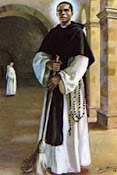
St. St. Dominic dedicated himself to promoting "pax et fides", "peace and faith", because without peace, the faith cannot flourish, and he described himself as pursuing this goal by "singing and gentleness, preaching, imploring and weeping" (cf. M.-H. Vicaire, O.P., St. Dominic and His Times, pp. 62 and nt. 7, 146, 147 and nt. 80)."
from Fr. Bartholomew de la Torre, O.P.














